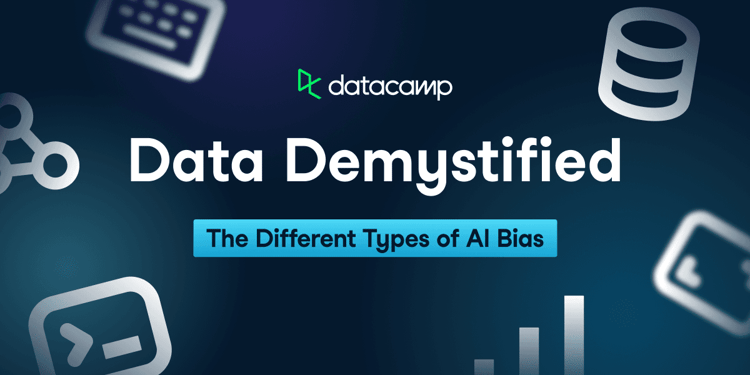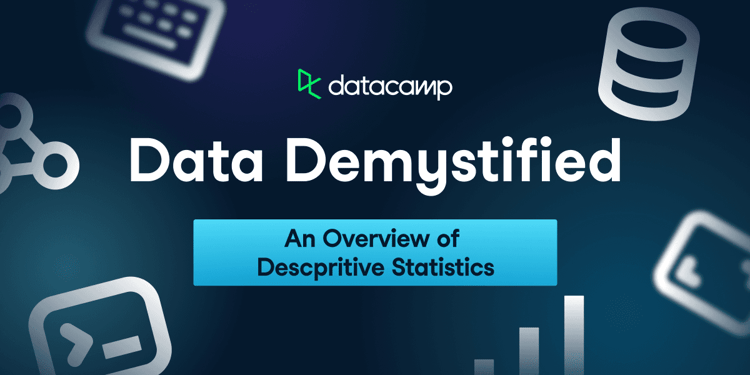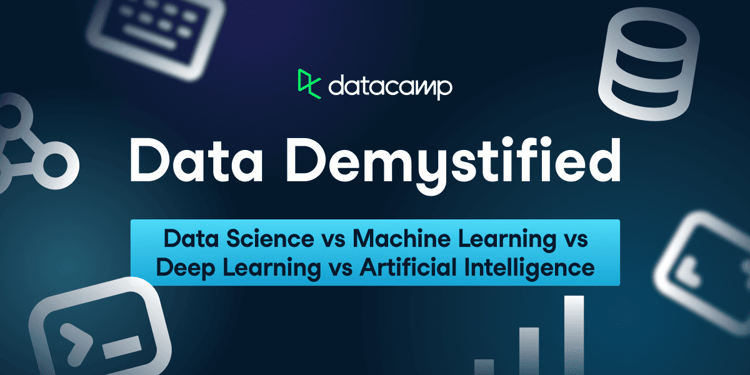Course
Welcome to the fourth part of our month-long data demystified series. As part of Data Literacy Month, this series will clarify key concepts from the world of data, answer the questions you may be too afraid to ask and have fun along the way. If you want to start at the beginning, read our first entry in the series: What is a Dataset?
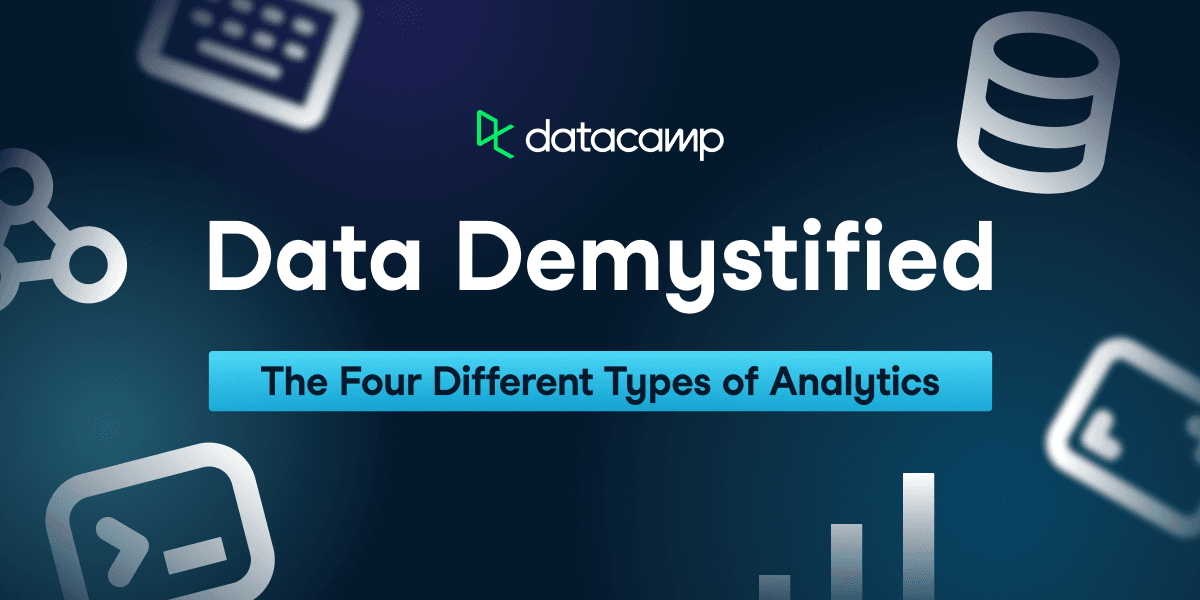
In this entry, we’ll explore the different types of analytics, from descriptive to prescriptive, identify the different types of questions data can answer, outline examples, and more.
Four types of questions, four types of analytics
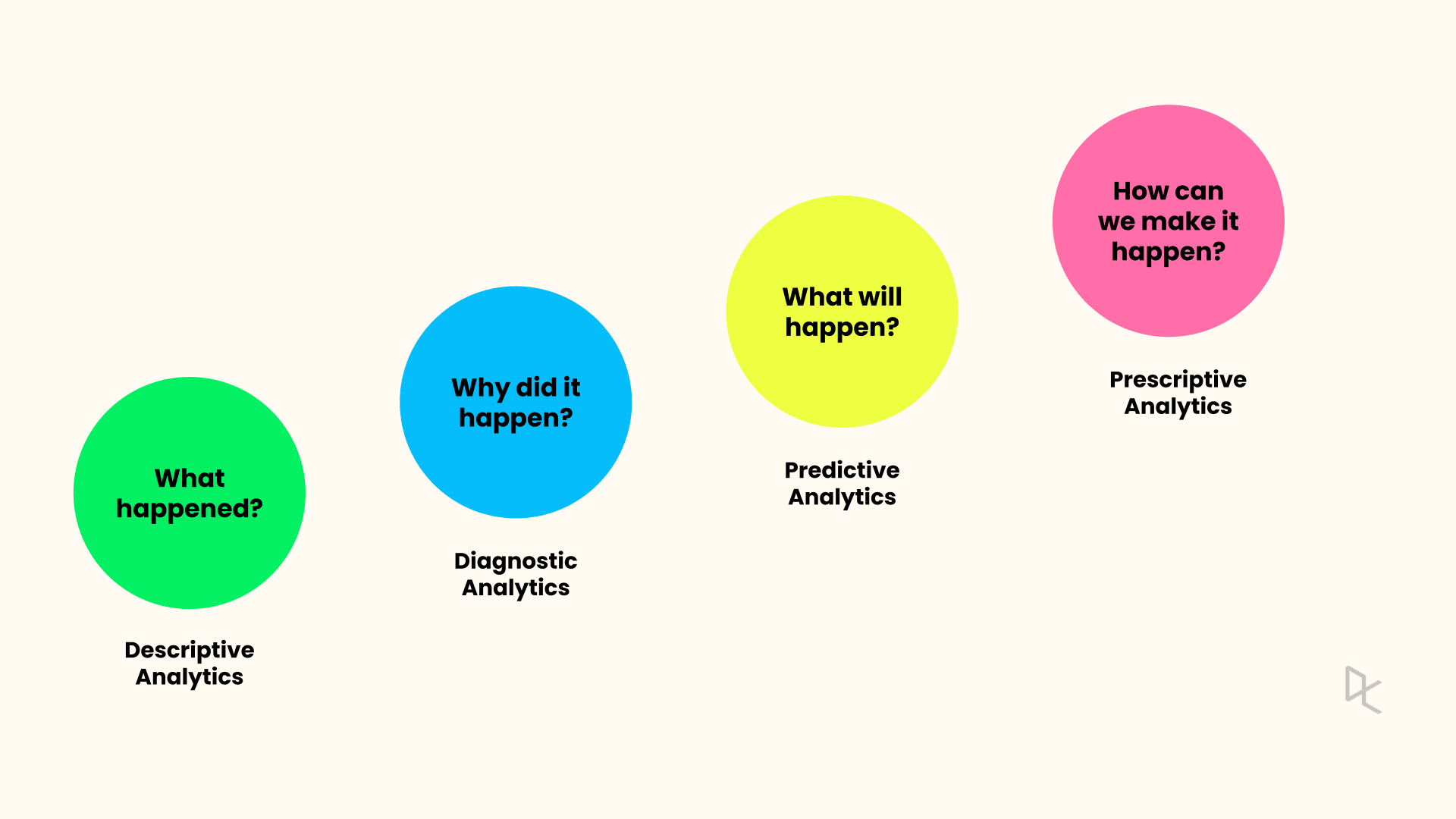
Data can be used to answer an almost infinite number of questions, but we can break those questions down into four categories. This naturally leads to different types of data analysis: each question category has a corresponding type of analytics.
|
Type of question |
Type of analytics |
|
What happened? |
Descriptive Analytics |
|
Why did it happen? |
Diagnostic Analytics |
|
What will happen? |
Predictive Analytics |
|
How can we make it happen? |
Prescriptive Analytics |
These four types of analysis are listed in increasing order of complexity. Depending on the scope of a data project, completing a full analysis may involve several types of analysis together.
Before deep diving into the different types of analytics, let's consider a real-world equivalent of a patient visiting a doctor. First, the doctor will examine the patient to get a description of the symptoms. Next, they will try to diagnose the medical problem causing the symptoms. Thirdly, they will try to predict how the symptoms will change over time (whether the patient will get better or worse). Finally, they will prescribe a treatment for the patient.
Descriptive Analytics: Understanding What Happened
Descriptive analytics answers questions of the form "what is happening?" or "what happened?".
The main techniques used in descriptive analytics are calculating summary statistics and drawing data visualizations. Summary statistics include counts of data, averages like the mean and median, and measures of variation like the range and standard deviation.
You can read more about summary statistics in the next entry of data demystified on descriptive statistics. Moreover, you can check out the following cheat sheet for a deep dive into data visualizations.
Descriptive Analytics Example
Let’s look at an example. Let’s say you want to understand your company’s revenue drivers. You perform descriptive analytics on your sales data, answering questions such as:
- How many sales were made in the last month? (The count of sales.)
- How much is the average transaction value? (The mean sale price.)
- How much variation is there between total sales per store? (The standard deviation of total sales by store.)
- What were the total sales per day? (A line plot of total sales versus date.)
Diagnostic Analytics: Understanding The Why
Descriptive analytics will often generate new questions. In the sales example, you may see that total sales were unexpectedly low on one Thursday. Knowing what happened is a helpful starting point, but it's not a satisfying conclusion to an analysis. The next obvious question is, "why were sales low that Thursday?".
This is a question that requires a diagnostic analysis. In general, diagnostic analyses answer questions of the form "why did something happen?". Usually, that something is an unexpectedly high or unexpectedly low value, also known as an outlier.
Diagnostic analytics often involves these steps:
- Forming hypotheses about why the unusual thing happened.
- Getting data related to the possible causes.
- Performing descriptive analytics on subsets of your data ("data mining").
- Fitting statistical models like regression to examine the relationship between the causes and the unusual thing.
One thing to note is that in many cases, you will only be able to determine a relationship between what you’re measuring and the suspected cause. You won't be able to prove that it genuinely is the cause. In an upcoming data demystified entry, we’ll be covering the pitfall of correlation vs. causation.
Diagnostic Analytics Example
Returning to our sales example, after discovering unexpectedly low total sales one Thursday last month, you decide to perform a diagnostic analysis on the sales data.
- Forming a hypothesis: Your first hypothesis is that sales were lower due to an outage in your website, blocking online sales.
- Getting data: You retrieve the website performance data.
- Descriptive analytics: You draw a line plot of the performance over time but don't see a dip on that Thursday. Next, you calculate the total sales split by online and in-store and see that the lower sales occurred in-store in one country region.
- Forming another hypothesis: You recall that that part of the country had a bad storm on that Thursday, and hypothesize that that may have driven customers away.
- Getting data: You retrieve weather data for each store location.
- Fitting statistical models: You fit a time series model to your total sales data, using the weather as an input to the model. This shows that bad weather is correlated with lower sales.
Predictive Analytics: Understanding What Will Happen
Data analysis doesn't only let you understand the past. the third type of analytics is around making predictions. These can be predictions about the future, in which the predictions are called forecasts, but that doesn't have to be the case. Predictions can also be around whether customers fit certain customer segments or whether a transaction is fraudulent or not. The main techniques involved in predictive analytics are statistical models, though, in the context of prediction, they are often called machine learning models.
You can read more about machine learning in the third entry of Data Demystified, on the difference between data science, artificial intelligence, machine learning, and deep learning.
Predictive Analytics Example
After diagnosing the issue with low sales, your boss is now worried about the next quarter and wants to know what revenue will be like in the coming months. As a consequence, you use the same time series model from before, this time to predict sales in the future.
Your boss would also like to understand which potential customers they should target based on who is most likely to buy things. As such, you create a machine learning model based on customers' properties, like their previous purchase history and estimated income, to predict the probability they will make a purchase.
Prescriptive Analytics: How Can We Make it Happen?
One of the big benefits of data analytics is that you can use it to help you make better decisions. That is, rather than using your gut feeling, you make data-driven decisions. Prescriptive analytics helps you answer questions of the form "What should we do?".
The techniques used in prescriptive analytics build upon the machine learning models of diagnostic and predictive analytics to let you explore different scenarios. Additionally, prescriptive analytics includes optimization to discover the best possible scenario from various choices.
Prescriptive Analytics Example
Your boss is in a quandary. The revenue predictions aren't as high as the board hoped, so your boss is now under pressure to develop ideas to increase it. They turn to you to come up with a data-driven solution.
- Between you and your boss, you come up with some possible scenarios for changing the in-store/online mix of sales and for changing the price of key products.
- You use predictive analytics to make predictions about each of these scenarios.
- After discovering some promising scenarios, you then use optimization to refine the scenario to the best possible outcome.
Want to Learn More?
We hope you enjoyed this short introduction to the different types of data analytics. In the next series entry, we’ll explore descriptive analytics more deeply and focus on the statistical techniques within descriptive analytics.
